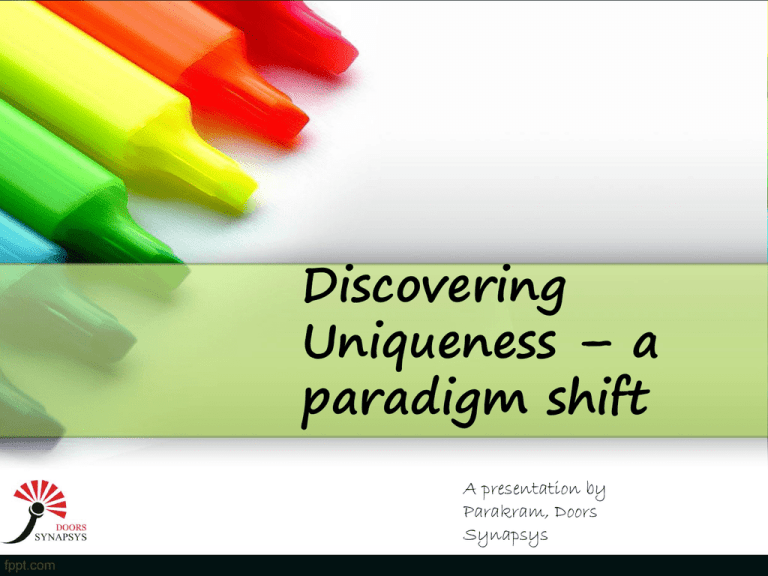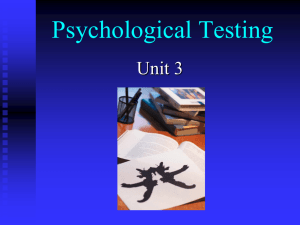- Doors Synapsys
advertisement

Discovering Uniqueness – a paradigm shift A presentation by Parakram, Doors Synapsys Think of a Paradigm Shift as a change from one way of thinking to another. It's • a revolution, • a transformation, • a sort of metamorphosis. It just does not happen on its own , but rather it is driven by agents of change and "one conceptual world view is replaced by another". Is it possible to identify future scientists, engineers, doctors, philosophers, musicians, artists, architects, astronauts, pilots, army officers, politicians, designers, actors, diplomats ….in this class ? Who are they ? I Want to help my child to succeed BUT don’t know how to go about it??? My child is good with something which is NOT recognized by teachers ! Interest areas of child and parents are different – “I want to be a designer v/s YOU should be an engineer ! “ Hyperactivity ! Learning Difficulties Concentration Problems Peer Rejection Disobedience Understanding Thinking Patterns The Essence of MI Theory • Respect for many differences among people • Multiple variations in the way they learn • Several modes of assessment • An infinite number of ways in which they can leave a mark on the world The metrics of Intelligence 1904: Alfred Binet, a French Psychologist was asked by the Minister of Public instruction to devise a test to find out which primary grade children were ‘at risk’ for failure. The ‘IQ’ Test was the result ‘IQ’ dominated the scene until 1983 Dr Gardner proposed the MI Theory ‘IQ’ is too narrow a concept …and there are at least 8 different ways a person can be ‘intelligent’ Gardner’s definition of Intelligence Intelligence is the ability to solve problems or fashion products that are of consequence in a particular cultural setting or community. Intelligence or only an ability ? 1. Potential isolation by brain damage 2. Existence of savants, prodigies, exceptional individuals 3. Distinctive developmental history 4. Evolutionary history 5. Psychometric/Psychological support 6. Identifiable core operations 7. Symbol System LINGUISTIC • Capacity to use words effectively – orator, story teller, poet, journalist • Ability to manipulate syntax (structure), phonology (sound), semantics (meaning), rhetoric (convincing), mnemonics (remembering), explanation (informing/educating) LOGICAL/MATHEMATICAL • Capacity to use numbers effectively – mathematician, statistician. • Capacity to reason – scientist, software programmer. • Sensitivity to logical patterns and relationships • If-then, cause-effect, inference, abstractions Visual/Spatial • Ability to perceive visual-spatial world accurately – guide, hunter, scout • Perform transformations upon those perceptions –interior designer, architect, artist • Sensitivity to color, line, shape, form and space • Capacity to visualize, graphically present ideas and to orient oneself in a spatial matrix Kinesthetic • Expertise in using one’s body to express ideas and feelings – actor, mime, athlete, dancer • Using hands to produce or transform things – craftsperson, sculptor, mechanic, surgeon • Specific physical skills – coordination, dexterity, flexibility, tactile and haptic (nonverbal communication) capacities Musical • Capacity to perceive, discriminate, transform and express musical forms • Musical aficionado, Composer, Performer • Sensitivity to rhythm, Pitch/Melody or Tone • Intuitional or Analytical understanding of music or both. • Emotional or Kinesthetic connect with music Interpersonal • Ability to perceive and make distinctions in the moods, intentions, motivations and feelings of others • Sensitivity to facial expressions, voices and gestures • Capacity for discriminating among various types of emotional cues • Ability to respond effectively to emotional cues (eg. Influencing others to follow a certain line of action. Intrapersonal They are good at understanding one's own interests, goals. These learners tend to shy away from others. They're in tune with their inner feelings; they have wisdom, intuition and motivation, as well as a strong will, confidence and opinions. They can be taught through independent study and introspection. Tools include books, creative materials, diaries, privacy and time. They are the most independent of the learners. Naturalistic People with a high degree of this intelligence are good at observing nature and their environment and are good at identifying natural things, birds, animals, plants, etc. They may be termed as being ‘one with nature’ and enjoy being in natural surroundings. This intelligence also has to do with being familiar with the environment around them, perceive potential threats and opportunities in their environment and also have a keen understanding of relationships between natural things. So… where does intelligence reside ? Its all here ! The lobes are like Departments ! The lobes are like Departments ! Personality Human Personality Dr William Marston’s Theory which was first propounded in 1920 in his book – ‘Emotions of Normal People’. It has been acknowledged to be the most enduring and acceptable theory of human personality. It is used widely as the DISC Theory. So, What is Personality ? • The word personality itself stems from the Latin word persona, which referred to a theatrical mask work by performers in order to either project different roles or disguise their identities. • "Although no single definition is acceptable to all personality theorists, we can say that personality is a pattern of relatively permanent traits and unique characteristics that give both consistency and individuality to a person's behavior." (Feist and Feist, 2009) The Four Types Why is it important ? • Parent personality is a major factor affecting how they communicate and deal with their child • Parent personality can affect learning outcomes via the psychological environment at home • Likewise, the child’s personality also influences the family environment Personality Types • LISTENER Emphasis : Cooperates with others within existing circumstances to carry out task. Tendencies : • Demonstrates patience • Develops specialized skills • Helps others willingly • Performs consistently • Shows loyalty • Listens patiently • Flourishes in a stable environment • Predictable • Friendly Preferred Environment : • Maintenance of status quo • Predictable routines • Minimal work infringement on home life • Thrives on sincere appreciation • Identifies with a group and is not individualistic • Avoids conflict Personality Types IDEAL IST (I) Emphasis : Works conscientiously within existing circumstances to ensure quality and accuracy Tendencies : • Concentrates on key details • Tends to be diplomatic and courteous • Fanatical about accuracy • Seeks perfection • Adheres to rules, regulations, directives and standards • Thinks analytically • Uses indirect approaches to conflicts • Uses systematic approach to situations • Fact finder, Precise • Careful and cautious Preferred Environment : • Clearly defined performance expectations • Reserved, business-like atmosphere • Control over factors that affect their performance • Recognition of specific skills and accomplishments Personality Types FLASHY (F) Emphasis : Shapes the environment by influencing or persuading others Tendencies : • Eager to meet people and socialize • Wants to create a good impression • Articulates very well and is a good conversationalist • Creates a motivational environment • Entertains people and believes in a ‘fun’ atmosphere • Can be overly optimistic • Loves to work in groups and being with people • Can be very persuasive • Can be impulsive and spontaneous • Can be very expressive and comfortable with expressing emotions • Can be very enthusiastic and charming Preferred Environment : • Popularity and Social Recognition • Public recognition of ability • Freedom of Expression • Group activities outside of job • Freedom from control and detail • Favorable work environment Personality Types EFFICIENT (E) Emphasis : Shapes the environment by overcoming opposition to accomplish results • Tendencies : • Strives for immediate results • Believes in causing action • Accepts challenges • Takes quick decisions • Questions status quo • Relishes authority • Likes to manage situations and solving problems • Task and achievement oriented • Can take risks • Egoistic Preferred Environment : • Power and authority • Prestige and challenge • Direct answers • Wide scope of operations • Opportunities for individual accomplishment • Opportunity for self advancement • Freedom from direct control and supervision by others • Likes new and varied activities How have we been teaching ? “There has been an emphasis on teaching and assessing children in predominantly two forms, two intelligences, linguistic and logicalmathematical” Gardner et al, 1993 Learning Styles Neil D. Fleming’s theory Propounded in 1987 through work done at Lincoln University, New Zealand and at several schools earlier after observing over 9000 school lessons. People acquire knowledge and information in one or more predominant ways, in other words a dominant or preferred style or a blend of three styles. •How does one learn best ? • What does one pay attention to ? • How does one recall the learning ? Visual Auditory Kinesthetic Learning Motivation Why do you learn what you learn ? What motivates you to learn ? Self Cognitive Affective Reflective Reverse/Contrary Brain Hemisphere Dominance Who told us ? • • The theory of Brain Dominance grew out of the work of Roger Sperry, who was awarded the Nobel Prize in 1981. Our brains have two hemispheres – the Left and Right Hemispheres which are connected by the corpus callosum. This allows the two hemispheres to communicate. While studying the effects of epilepsy, Sperry discovered that by severing the corpus callosum he could reduce epileptic seizures. But he also observed that since the corpus callosum was the information highway between the two hemispheres the patients exhibited some other symptoms. For example the patients were unable to name objects processed visually on the right side of the brain but were able to name objects processed on the left side. This caused Sperry to theorize that language is a left brain activity. Left v/s Right • • • • • • LEFT The Left Brain is adept at tasks that involve logic, language and analytical thinking. Language Logic Critical Thinking Numbers Reasoning Convergent thinking RIGHT • • • • • • • • • The Right Brain is best at expressive and creative tasks. Recognizing faces Expressing emotions Music Reading emotions Color Images Intuition Creativity Divergent thinking Face or Fruits ? Innate Quotients In most psychometric tests the emphasis is on IQ which is nothing but a combination of Logical-Mathematical and Linguistic Intelligence which are both Left Brain attributes. Is it fair to judge on IQ alone? IQ EQ AQ CQ Discovering Uniqueness “ We worry about what the child will become tomorrow , yet we forget that she is someone today “ But lets see Why ?? • Each child is unique and intelligent in a distinct way • Each child has a unique potential to excel • The uniqueness is innate to a great extent • Each Teacher is also different and so are the parents • We just have to discover this uniqueness….and harness it to maximize true learning What to do differently ? • Teaching in multiple ways • Identifying VAK Modes and Brain Dominance • Understanding Personality of the Teacher and the Taught • Understanding MI Profiles, AQ, EQ,CQ and IQ of children • School-wide themes – eg : Environment, Heritage, “Then & Now” • Pods : Special Learning Groups created by children • Flow Room : MI Lab Concept • Tutorials by senior students • Involvement of Parents • Customized Assessments and Assignments • Mentorships and Apprentice Programs



